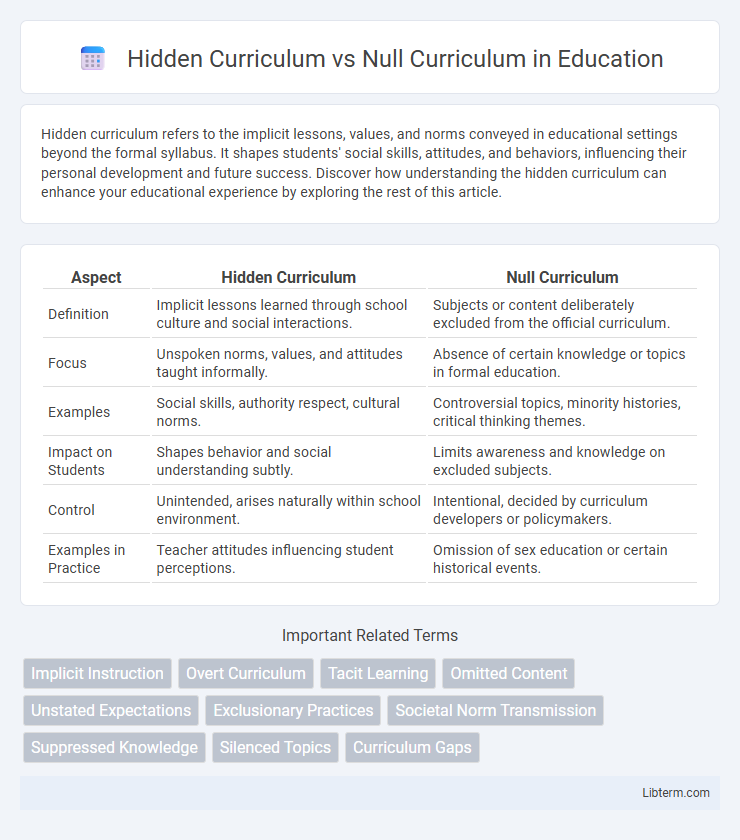Hidden curriculum refers to the implicit lessons, values, and norms conveyed in educational settings beyond the formal syllabus. It shapes students' social skills, attitudes, and behaviors, influencing their personal development and future success. Discover how understanding the hidden curriculum can enhance your educational experience by exploring the rest of this article.
Table of Comparison
| Aspect | Hidden Curriculum | Null Curriculum |
|---|---|---|
| Definition | Implicit lessons learned through school culture and social interactions. | Subjects or content deliberately excluded from the official curriculum. |
| Focus | Unspoken norms, values, and attitudes taught informally. | Absence of certain knowledge or topics in formal education. |
| Examples | Social skills, authority respect, cultural norms. | Controversial topics, minority histories, critical thinking themes. |
| Impact on Students | Shapes behavior and social understanding subtly. | Limits awareness and knowledge on excluded subjects. |
| Control | Unintended, arises naturally within school environment. | Intentional, decided by curriculum developers or policymakers. |
| Examples in Practice | Teacher attitudes influencing student perceptions. | Omission of sex education or certain historical events. |
Understanding Hidden Curriculum: An Overview
Hidden curriculum refers to the implicit lessons, values, and norms conveyed through the educational environment and social interactions rather than formal instruction. It shapes student behavior, attitudes, and socialization, often reinforcing societal structures and cultural expectations without explicit acknowledgement. Understanding hidden curriculum helps educators recognize how non-academic factors influence learning experiences and student development alongside the formal curriculum.
Defining Null Curriculum: What’s Not Taught
Null curriculum refers to the knowledge, skills, and values that are intentionally or unintentionally excluded from formal education. Unlike hidden curriculum, which involves implicit lessons conveyed through the educational environment, null curriculum highlights what is omitted from textbooks, lesson plans, and assessments. This exclusion shapes students' understanding by signaling which topics and perspectives are considered unimportant or unacceptable in the academic setting.
Key Differences Between Hidden and Null Curriculum
The hidden curriculum refers to the implicit lessons, values, and norms conveyed through the educational environment and social interactions, whereas the null curriculum consists of the knowledge and topics intentionally omitted or excluded from formal instruction. Key differences include that the hidden curriculum shapes students' social and cultural understanding indirectly, while the null curriculum influences learning gaps by omission. The hidden curriculum operates through subtle, informal processes, whereas the null curriculum is characterized by explicit decisions about what content is left out of the syllabus.
Historical Perspectives on Curricular Concepts
The hidden curriculum refers to the implicit lessons, values, and norms transmitted through the educational environment, while the null curriculum encompasses the content intentionally omitted from formal instruction. Historically, educational theorists like Philip W. Jackson highlighted the hidden curriculum's role in socializing students beyond academic knowledge, whereas Jerome Bruner emphasized the null curriculum's significance in shaping cultural and ideological perspectives by exclusion. These concepts reveal how curricular choices reflect broader societal power dynamics and historical contexts influencing educational priorities.
Impacts of Hidden Curriculum on Student Development
Hidden curriculum profoundly shapes student development by imparting implicit social norms, values, and attitudes not formally included in the syllabus. This covert learning influences students' social skills, cultural understanding, and moral reasoning, often reinforcing societal inequalities or promoting conformity. The impact of hidden curriculum can either support or hinder students' holistic growth, affecting their academic motivation and interpersonal relationships.
Consequences of the Null Curriculum in Education
The null curriculum, representing what is omitted or ignored in educational content, can lead to significant gaps in student knowledge and reinforce social inequalities by marginalizing certain perspectives or topics. This absence of critical subjects, such as comprehensive sex education or diverse cultural histories, limits students' ability to develop a well-rounded worldview and critical thinking skills. Consequently, the null curriculum shapes students' attitudes and values implicitly, often perpetuating systemic biases and reducing preparedness for real-world challenges.
Examples of Hidden Curriculum in Schools
Hidden curriculum in schools includes informal lessons on social norms and values, such as cooperation during group projects, punctuality encouraged through daily schedules, and respect learned by interacting with diverse peers. Examples also encompass unspoken expectations like obedience to authority, gender roles reinforced by teacher behavior, and competitive attitudes fostered through grading systems. In contrast, null curriculum refers to the knowledge and skills deliberately excluded from formal education, such as critical discussions on controversial topics or alternative historical perspectives.
Identifying the Null Curriculum: What’s Missing?
The Null Curriculum refers to the knowledge, skills, and values that schools intentionally omit from their official teaching agendas, creating gaps in students' learning experiences. Identifying the Null Curriculum involves analyzing curriculum standards, classroom practices, and assessment frameworks to uncover topics and perspectives that are systematically excluded or marginalized. Recognizing these omissions is essential for educators to address bias, promote inclusivity, and ensure a comprehensive educational experience that reflects diverse societal needs.
Addressing Biases in Hidden and Null Curriculum
Addressing biases in the hidden curriculum involves recognizing and modifying the implicit messages, values, and norms conveyed through school culture, teacher attitudes, and peer interactions to promote inclusivity and equity. Interventions in the null curriculum require identifying and integrating omitted critical content, particularly related to marginalized perspectives and social justice issues, to ensure comprehensive and unbiased educational experiences. Effective strategies include ongoing teacher training, curriculum reviews, and inclusive policy reforms that collectively minimize bias and support diverse student identities.
Strategies for Educators: Balancing Both Curriculums
Educators can balance hidden and null curricula by intentionally addressing implicit social messages while identifying and incorporating overlooked content areas into lesson plans. Employing reflective practices and inclusive pedagogy helps reveal underlying biases and gaps, ensuring a comprehensive educational experience. Strategic curriculum design that integrates explicit discussions and diverse perspectives promotes awareness and equity in learning environments.
Hidden Curriculum Infographic

 libterm.com
libterm.com